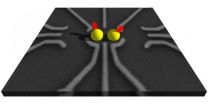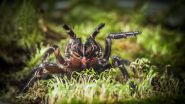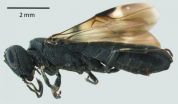(Press-News.org) This news release is available in French.
Chemical substances that are safe for humans when taken in isolation can become harmful when they are combined. Three research teams bringing together researchers from Inserm and CNRS in Montpellier have elucidated in vitro a molecular mechanism that could contribute to the phenomenon known as the "cocktail effect." This study is published in the journal Nature Communications.
Every day we are exposed to many exogenous compounds such as environmental pollutants, drugs or substances in our diet. Some of these molecules, known as endocrine disruptors, are strongly suspected of interacting inappropriately with regulatory proteins in our cells, and inducing numerous physiological or metabolic disorders (cancers, obesity, diabetes, etc.). Moreover, the combination of these molecules in complex mixtures with which we are in routine contact might exacerbate their toxicity.
In an article to be published in Nature Communications, researchers have unveiled a mechanism that might contribute to this effect of mixing, for which no rational explanation has been offered until now. They show that some oestrogens such as ethinyloestradiol (one of the active ingredients of contraceptive pills) and organochlorine pesticides such as trans-nonachlor, although very weakly active on their own, have the ability to bind simultaneously to a receptor located in the cell nucleus, and to activate it synergistically.
Analyses at molecular level indicate that the two compounds bind cooperatively to the receptor, i.e. binding of the first molecule promotes binding of the second. This cooperativity is due to strong interactions at the level of the receptor binding site, so that the binary mixture induces a toxic effect at substantially lower concentrations than the individual molecules.
These results obtained in vitro constitute a proof of concept that opens the way to a wide field of study. There are actually about 150,000 compounds in our environment that could have unexpected effects on human health through combined action, given their recognised or assumed safety as isolated substances. If these studies are confirmed in vivo, important consequences are expected in the areas of endocrine disruption, toxicology, and the assessment of risks associated with the use of chemicals.
INFORMATION:
Figure: Separately, ethinyloestradiol (EE2) and trans-nonachlor (TNC) bind to the xenobiotic receptor (PXR) only at high concentrations, and are weak activators of this receptor. When they are used together, the two compounds mutually stabilise each other in the binding pocket of the receptor. The "supramolecular ligand" thus created has increased affinity for PXR, so that it can induce a toxic effect at doses at which each compound is inactive individually.
SOURCES
Source
Synergistic activation of human pregnane X receptor by binary cocktails of pharmaceutical and environmental compounds
Vanessa Delfosse1-3,13, Béatrice Dendele3-6,13, Tiphaine Huet1-3,13, Marina Grimaldi3-6, Abdelhay Boulahtouf3-6, Sabine Gerbal-Chaloin3,7, Bertrand Beucher3,8,9, Dominique Roecklin10, Christina Muller10, Roger Rahmani11, Vincent Cavaillès3-6, Martine Daujat-Chavanieu3,7,12, Valérie Vivat10, Jean-Marc Pascussi3,8,9, Patrick Balaguer3-6,14* & William Bourguet1-3,14*
1 Inserm U1054, Montpellier, France;
2 CNRS UMR5048, Centre de Biochimie Structurale, Montpellier, France;
3 Université de Montpellier, Montpellier, France;
4 IRCM, Institut de Recherche en Cancérologie de Montpellier, Montpellier, France;
5 Inserm, U1194, Montpellier, France;
6 ICM, Institut régional du Cancer de Montpellier, Montpellier, France;
7 Inserm U1040, Montpellier, France;
8 Inserm U661, Montpellier, France;
9 CNRS UMR5203, Institut de Génomique Fonctionnelle, Montpellier, France;
10 NovAliX, Illkirch, France;
11 INRA UMR 1331, TOXALIM, Sophia-Antipolis, France;
12 CHU de Montpellier, Institut de Recherche en Biothérapie, Montpellier, France
13 These authors equally contributed to this work
14 These authors jointly supervised this work
Nature Communication
Investigator contacts
William Bourguet
Inserm Research Director
Centre for Structural Biochemistry (CBS)
CNRS UMR 5048, Inserm U1054, Montpellier University
bourguet@cbs.cnrs.fr
+ 33 (0)4 67 41 77 02
Patrick Balaguer
Inserm Research Director
Montpellier Cancer Research Institute (IRCM)
Inserm U1194, Montpellier University
patrick.balaguer@inserm.fr
+ 33 (0)4 67 61 24 09
Press contact
Access the Inserm press room: presse-inserm.fr/en/
The press release in English :http://presse-inserm.fr/en/light-shed-on-the-underside-of-the-cocktail-effect-of-endocrine-disruptors/20453/
In French : http://presse-inserm.fr/les-dessous-de-leffet-cocktail-des-perturbateurs-endocriniens-reveles/20453/
Got rope? Then try this experiment: Cross both ends, left over right, then bring the left end under and out, as if tying a pair of shoelaces. If you repeat this sequence, you get what's called a "granny" knot. If, instead, you cross both ends again, this time right over left, you've created a sturdier "reef" knot.
The configuration, or "topology," of a knot determines its stiffness. For example, a granny knot is much easier to undo, as its configuration of twists creates weaker forces within the knot, compared with a reef knot. For centuries, sailors have observed such ...
WORCESTER, MA -- Researchers at the University of Massachusetts Medical School are the first to show that it's possible to reverse the behavior of an animal by flipping a switch in neuronal communication. The research, published in PLOS Biology, provides a new approach for studying the neural circuits that govern behavior and has important implications for how scientists think about neural connectomes.
New technologies have fueled the quest to map all the neural connections in the brain to understand how these networks processes information and control behavior. The human ...
SALT LAKE CITY, Sept. 7, 2015 - If you are in a special relationship with another person, thank grandma - not just yours, but all grandmothers since humans evolved.
University of Utah anthropologist Kristen Hawkes is known for the "grandmother hypothesis," which credits prehistoric grandmothering for our long human lifespan. Now, Hawkes has used computer simulations to link grandmothering and longevity to a surplus of older fertile men and, in turn, to the male tendency to guard a female mate from the competition and form a "pair bond" with her instead of mating with ...
Physicists from the Department of Nanophotonics and Metamaterials at ITMO University have experimentally demonstrated the feasibility of designing an optical analog of a transistor based on a single silicon nanoparticle. Because transistors are some of the most fundamental components of computing circuits, the results of the study have crucial importance for the development of optical computers, where transistors must be very small and ultrafast at the same time. The study was published in the scientific journal Nano Letters.
The performance of modern computers, which ...
Developing transparent or semitransparent solar cells with high efficiency and low cost to replace the existing opaque and expensive silicon-based solar panels has become increasingly important due to the increasing demands of the building integrated photovoltaics (BIPVs) systems. The Department of Applied Physics of The Hong Kong Polytechnic University (PolyU) has successfully developed efficient and low-cost semitransparent perovskite solar cells with graphene electrodes. The power conversion efficiencies (PCEs) of this novel invention are around 12% when they are illuminated ...
Calculation with electron spins in a quantum computer assumes that the spin states last for a sufficient period of time. Physicists at the University of Basel and the Swiss Nanoscience Institute have now demonstrated that electron exchange in quantum dots fundamentally limits the stability of this information. Control of this exchange process paves the way for further progress in the coherence of the fragile quantum states. The report from the Basel-based researchers appears in the scientific journal Physical Review Letters.
The basic idea of a quantum computer is to ...
DENVER, Colo. -- The International Association for the Study of Lung Cancer (IASLC) today issued a new statement on Tobacco Control and Smoking Cessation at the 16th World Conference on Lung Cancer (WCLC) in Denver. The statement calls for higher taxes on tobacco products, comprehensive advertising and promotion bans of all tobacco products and product regulation including pack warnings.
"Tax policies that increased the cost of cigarettes have played a prominent role in the reduction of cigarette smoking," said Dr. Kenneth Michael Cummings, Professor, Hollings Cancer ...
Scientists studying funnel-web spiders at Booderee National Park near Jervis Bay on the New South Wales south coast have found a large example of an unexpected funnel-web species.
The scientists believe the 50-millimetre spider is a species of the tree-dwelling genus Hadronyche, not the ground-dwelling genus Atrax, which includes the Sydney funnel-web, the only species reported in the Park's records.
"It's remarkable that we have found this other species in Booderee National Park," said Dr Thomas Wallenius, from The Australian National University (ANU).
"It shows ...
Graphene, the ultra-thin, ultra-strong material made from a single layer of carbon atoms, just got a little more extreme. University of British Columbia (UBC) physicists have been able to create the first ever superconducting graphene sample by coating it with lithium atoms.
Although superconductivity has already been observed in intercalated bulk graphite--three-dimensional crystals layered with alkali metal atoms, based on the graphite used in pencils--inducing superconductivity in single-layer graphene has until now eluded scientists.
"This first experimental realization ...
Social network Flickr and citizen science website BugGuide have helped scientists to expand the known range of a rarely collected parasitic woodwasp, native to the eastern United States. Partially thanks to the two online photograph platforms, now the species' distribution now stretches hundreds of miles west of previous records. Previously known from only 50 specimens mainly from the Northeast, now the species was discovered in the Ozark Mountains by researchers from the University of Arkansas. Their study is published it in the open access journal Biodiversity Data Journal.
Spurred ...





